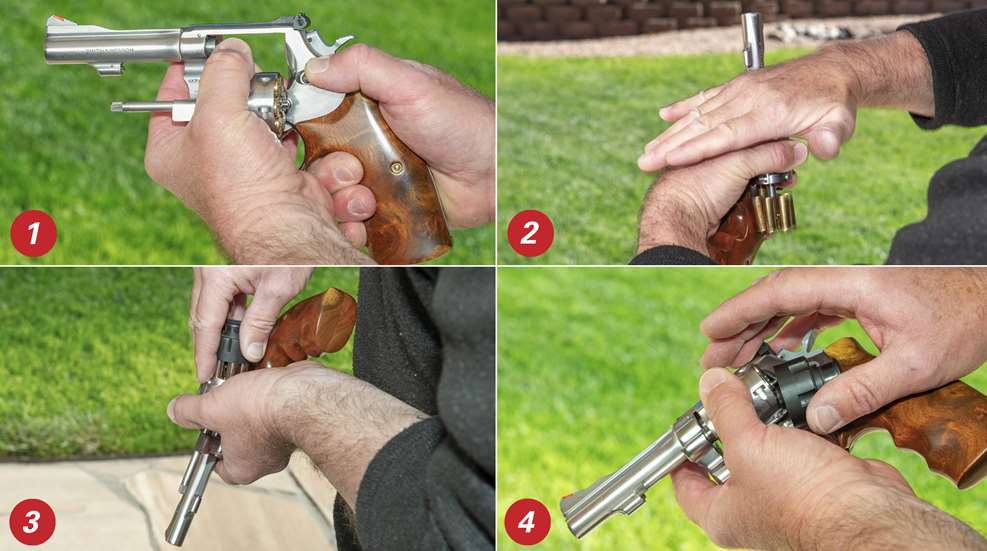
1. When starting the reload, bring the gun in close to the body. Use the right thumb to activate the cylinder release, then push out/trap the cylinder using the left fingers and thumb. 2. With the muzzle held upward, use the right palm to firmly slap the ejector rod to jettison empties. 3. Use the left hand to re-orient the muzzle downward, then use the right hand to retrieve the speedloader and index it to the cylinder, aligning it with the two outboard chambers before releasing the cartridges. 4. As the right hand lets go of the loader, use the left hand to close the cylinder, then re-establish a firing grip.
Revolvers have seen a resurgence in popularity recently as a new generation of shooters discover the advantages they offer. Most experts acknowledge the “real-world” reliability that revolvers display when adrenaline is freely flowing and conditions deteriorate to less than perfect. This reputation for reliability is largely based on revolvers being more resistant to external factors. For instance, they don’t require a proper firing grip (for recoil-spring function) like semi-automatics do, and they’re more likely to work when in contact with objects that would slow slide travel and cause malfunctions in self-loaders.
In addition, revolvers aren’t affected by reduced dimensions; the smallest ones retain the reliability of service-size guns. The smaller a semi-automatic pistol is, the more ammunition-sensitive it tends to become. Further, the revolver’s heavier double-action trigger provides an extra margin of safety over a striker-fired semi-automatic when handling a gun under stressful conditions, and the long, heavy trigger pull provides peace of mind when carrying the gun close to the body as well. Small revolvers are also easier to conceal because they lack sharp angles and their “organic” shape helps contribute to comfortable all-day carry.
But, while revolvers offer plenty of pros, they’re not without cons. One of the most cited disadvantages with carry revolvers is their limited ammunition capacity of five or six rounds. There are a few available with seven- and eight-round cylinders (and rimfire variants holding nine or 10), but their increased width puts them at the outer margin of concealability for most people.
Ways To Get It Done
The revolver’s minimal capacity makes carrying spare ammunition more critical than with a higher-capacity self-loader. It also makes reloading skill more likely to be needed in an altercation where the handgun is fired. There are many ways to load a revolver, and all of them are slower than jamming a tapered magazine into a beveled magazine well.
Loading single loose rounds from a pocket or dump pouch is the slowest and most challenging way and should be avoided if possible. Lots of revolver shooters use speed strips or a 2x2x2 pouch because they allow loading two rounds at a time and conceal very well. Pouches and strips are quicker than loading loose rounds but are still slow.
The quickest way to reload a revolver is by using full-moon clips or speedloaders. Moon clips are typically used with revolvers chambered in semi-automatic cartridges such as 9 mm Luger or .45 ACP. Revolvers chambered for conventional rimmed cartridges such as .38 Spl. can be modified to accept moon clips, but the process is not inexpensive; it involves a gunsmith milling the back of the cylinder. The clips can be bent and damaged with rough handling, and cartridges are best loaded and unloaded from the clips with tools. Speedloaders are the best choice for most revolver shooters to get fresh ammunition on board quickly.
Speedloader Types
There are several manufacturers currently building speedloaders for popular revolvers. Hopefully, the market will expand to accommodate the increased level of interest and cover new and less common models of revolvers. Speedloaders can be broken into three basic categories. The first type relies on gravity to drop fresh cartridges into the chambers of the cylinder.
Models from HKS (hksspeedloaders.com), 5 Star (5starfirearms.com) and Pachmayr (lymanproducts.com) require turning a knob on top of the loader to release cartridges—the HKS knob rotates clockwise to release, while the 5 Star and Pachmayr rotate counterclockwise. The Safariland (safariland.com) Comp I and II only require downward pressure on the body of the loader to release their cartridges. Gravity loaders tend to be the most rugged and compact. The HKS and 5 Star accommodate the largest variety of guns, but the Safariland Comp I is currently only made for five-shot Smith & Wesson J-frame revolvers in .38 Spl./.357 Mag. and N-frame six-shot S&Ws in .44 caliber. The Comp II is made for .38 Spl./.357 Mag.-chambered S&W K- and L-frames, Colt Python/Trooper, and Ruger GP100 and Security-Six models.
The second kind of loaders allow for manual pressure on a top “button” to help seat the cartridges into the cylinder. The cartridges are held in the loader by a single coil spring wrapped around the loader body below the cartridge rims. First seen on the now-defunct Dade speedloader, the concept has been adopted and improved by Speed Beez (speedbeez.com). The Dade can still be found on the used market, most often for S&W K and L frames and Colt .357 revolvers. The Speed Beez incorporates a large knob and is a very fast loader to use. The disadvantage with the Speed Beez and (on a slightly lesser level) the Dade is the propensity for them to lose cartridges when roughly handled or dropped. This makes them more suited for competition or recreational pursuits where a botched reload is less likely to be life-altering.
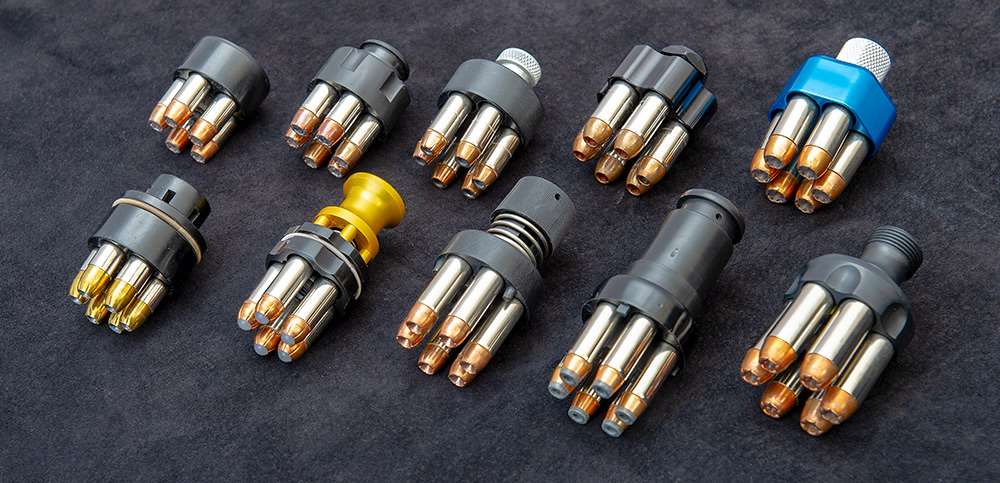
The last type of loader is spring-loaded to mechanically push cartridges into the chambers; the JetLoader (pistoleer.com), Safariland Comp III and S.L. Variant are examples. The Austrian-made JetLoader is a great speedloader, unfortunately, it is only made for S&W J-, K- and L-frame revolvers in .38/.357 (along with Ruger SP101, similar Taurus models and Ruger GP100 revolvers, respectively). The Safariland Comp III is similar in function to the JetLoader; it’s made to fit S&W K frames and L frames (the L-frame loader will also work with Ruger’s GP100) in .38/357.
The original S.L. Variant was made in Germany and is either out of production or no longer being imported. Each cartridge had its own spring to assist in chambering rounds. It was made for several frame sizes and cartridges and is highly sought-after. A Japanese manufacturer is currently producing a copy of the S.L. Variant which is imported by KazTac (kaztac.com). The mechanical push these loaders provide is beneficial, especially if the revolver’s cylinder isn’t vertical when the load is performed. They are uniformly larger than gravity-feed loaders because of the springs/knobs used.
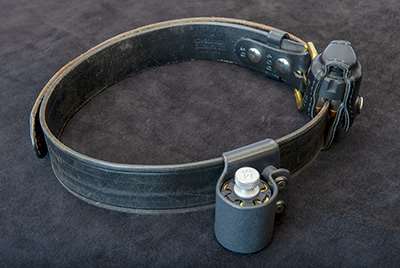
Carrying Your Reloads
If the choice is made to carry a revolver for defensive purposes, it’s a good idea to carry a speedloader in a dedicated pouch. This will ensure the loader is properly oriented and where it’s supposed to be when you really need it. For maximum concealment, look at the pouches that orient half of the cartridges behind the belt and half in front. These help to minimize the bulk and are less likely to print under clothing. Safariland’s (sadly) discontinued Split-Six or the DeSantis (desantisholster.com) Second Six are good examples. Carriers that place the entire loader inside the pants are made, but the girth of most loaders make these uncomfortable for all-day carry. Simply Rugged Holsters (simplyrugged.com) recently released an innovative pouch dubbed the Sidewinder that securely holds speedloaders horizontally above the belt. It hides well and works with common loaders and moon clips, making it an excellent choice. Hopefully more makers will recognize the need for concealable support gear as the carry revolver regains popularity.
Speedloader Techniques
There are several methods taught to reload revolvers with speedloaders; I advocate the “Universal Method” as a solid baseline to learn and use. This technique allows the shooting hand to do the actual loading while the typically less-dexterous support hand holds the gun. It may feel foreign to shooters whose handgun experience has been self-loader heavy (where the shooting hand maintains the firing grip during the reload and the support hand does the work). Loading a revolver cylinder with a speedloader holding multiple cartridges is a more complex motor skill than shoving a magazine into a mag well, so it’s easier to do with the dominant hand.
Bringing the elbows back to the body makes it easier to work with the revolver. For a right-handed shooter, the first step in the reload is to bring the supporting left hand up and forward to position the fingers on the right side of the cylinder and the thumb on the cylinder’s left side. Simultaneously, the right thumb activates the thumb piece or cylinder release. The cylinder can be rolled or pushed out fully by the left fingers while being supported by the left thumb. The size of the revolver and your hands will dictate how many fingers you run through the cylinder window. Most people can get their middle and ring finger around the cylinder on a service revolver and use the index finger and pinky to support the frame. Smaller guns like S&W J frames and Ruger LCRs may be easier to manipulate by using only the index finger to support the cylinder through the window. Doing so will also keep your hand from interfering with the next step.
Rotating the gun to a muzzle-up vertical posture gives you the highest probability of cleanly ejecting the empty cases, allowing gravity to assist. Once vertical, use the palm of the right hand to smartly strike the ejector/extractor rod to drive the empties out. One good strike should suffice, being mindful to keep the hand clear of the muzzle. Using the flat palm gives the most surface area to guarantee positive contact with the ejector rod and also helps to keep the strike straight down. The ejector rod can be bent from repeated angled strikes, compromising its function. This is where the Universal Method differs from the “FBI Method.”
In that technique, the left thumb is used to depress the ejector rod while the right hand acquires a speedloader. It’s marginally faster, if everything works. But the thumb may not have enough strength to reliably eject a swelled or split case and cannot always generate the needed inertia to force cases completely free. And repeatedly pumping the thumb on the rod can allow a case rim to slip underneath the extractor star. This situation takes some time to remedy and renders the revolver inoperable until corrected. Using the strong-hand palm is worth the extra time it takes to guarantee the empties clear out completely.
After the strike has been applied, the right hand secures a speedloader (right-handed shooters should store the primary speedloader on the right side of the body—opposite of where they would customarily carry a pistol magazine). Regardless of the action required to release rounds from a speedloader, it makes sense to grasp the loader by its body, with the fingertips in contact with the cartridges housed in the loader. This allows the fingers to guide the cartridges into the cylinder and index them into the chambers when contact has been made. While the right hand fetches a loader, the left hand is rotating the gun until the muzzle faces downward, allowing gravity to assist the loaded rounds to fall fully into the chambers. The left hand can pull the gun to the center of the body just above the belt line. This provides consistent reference, even in the dark. The eyes may leave the environment briefly to visually assist seating the cartridges, but it’s easier to get the barrel vertical, muzzle down, and control the gun with it in close.
Lining up two cartridges with chambers at the outside positions (around 9 and 11 o’clock) of the open cylinder will orient all remaining cartridges. Once the rounds are indexed, press the loader body or activate the knob to release the cartridges into the cylinder. Let go of the loader and roll the cylinder back into battery, controlling it with the fingers and thumb until it locks in. The firing grip can then be re-established with both hands.

Southpaw Tips
Left-handed shooters can use the left thumb or index finger to activate the cylinder release. I’ve found that the thumb works well on S&W and Taurus releases that push forward, and on Colts that pull rearwards. I’ve had better luck using the knuckle of the trigger finger on “push-button” releases like the Ruger or Kimber. The knuckle presses in on the release and the left thumb can provide pressure on the frame opposite the release in a pinching motion to provide the needed leverage. The right thumb pushes the cylinder out and traps it open with the right index finger. The muzzle is rotated up and the left palm delivers the strike to the ejector rod.
In closing, pick a speedloader and ammunition that work with your revolver. If the grips cause issues, replace or modify them. Acquire some inert cartridges that mimic the weight of live rounds to use for practice. Loading a revolver with speedloaders may be rehearsed without any live fire and can be safely done at home.
Practice like your life depends on it—because, someday, it just might.












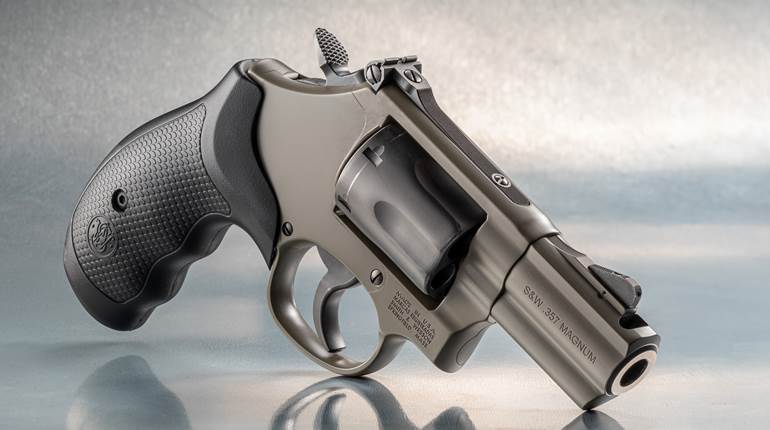
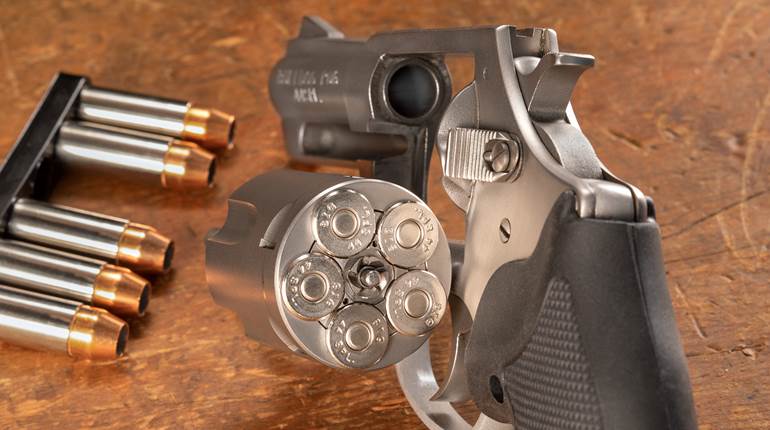
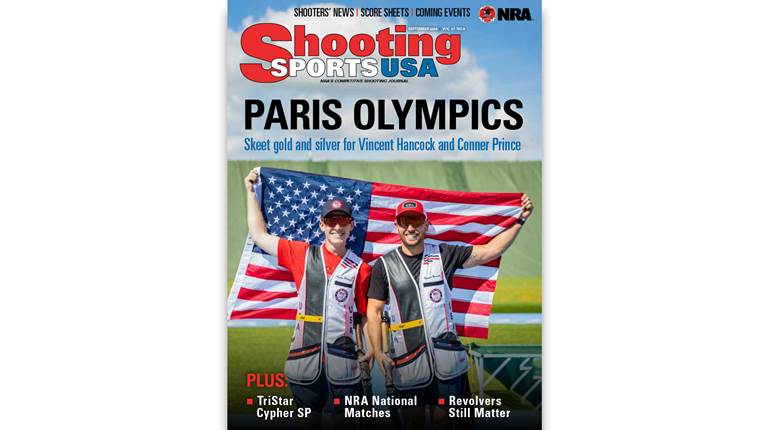
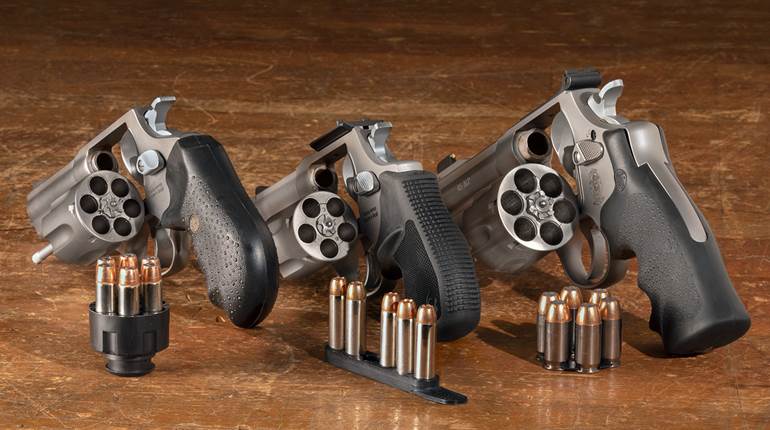







![Winchester Comm[94]](/media/1mleusmd/winchester-comm-94.jpg?anchor=center&mode=crop&width=770&height=430&rnd=134090756537800000&quality=60)
![Winchester Comm[94]](/media/1mleusmd/winchester-comm-94.jpg?anchor=center&mode=crop&width=150&height=150&rnd=134090756537800000&quality=60)












